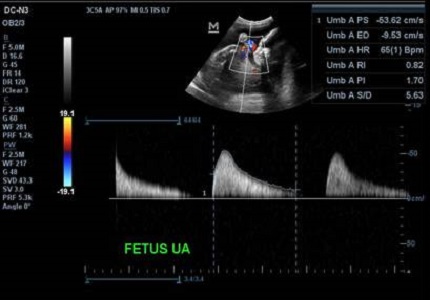Doppler velocimetry in dichorionic twin pregnancies and its correlation with various fetal outcome
Abstract
Aim: This study was to evaluate the applicability of Doppler velocimetry to determine its correlation with fetal outcome in dichorionic twin pregnancies.
Material and methods: Doppler examination of the umbilical artery (UA) and middle cerebral artery (MCA) was performed in 57 twin pairs. Abnormal values of the umbilical artery pulsatility index (PI), umbilical artery Resistive index (RI) were above the 95th percentile and below 5th percentile for the Middle cerebral artery pulsatility index (MCA PI) and Middle cerebral artery resistivity index (MCA RI) for gestational week. The difference of UA PI ≥0.5 in twin pairs was considered abnormal.
Results: 33 subjects had a fetal discordance of greater than 15%. Birth weight was found to be significantly lower in subjects with Umbilical artery PI greater than 95th percentile for gestational age (p=0.014). Abnormal MCA RI (P=0.018) and Umbilical artery RI values above 95th percentile was significantly associated with increased risk of IUGR (intra uterine growth restriction) (P=0.036) and NICU (Neonatal intensive care unit) admission (P=0.005). Increased Umbilical artery PI values above 95th percentile was significantly associated with IUGR (P=0.003). Increased Umbilical Artery systolic/diastolic ratio above 95th percentile was significantly associated with IUGR (P=0.002), NICU admission (P=0.026) and still birth (P=0.026). Abnormal cerebra-umbilical ratio (<1.08) was significantly associated with IUGR (P=0.001) and still birth (P=0.025). Difference in pulsatility index of umbilical artery of both fetus (P1-P2 >0.5) was significantly correlated with increased degree of birth weight discordance of the twins, IUGR (P=0.001) and still birth (P=0.001).
Conclusion: Abnormal Doppler values in discordant twin fetus are more likely to be associated with abnormal fetal outcome.
Downloads
References
Martin JA, Hamilton BE, Sutton PD, Ventura SJ, Menacker F, Kirmeyer S, Munson ML; Centers for Disease Control and Prevention National Center for Health Statistics National Vital Statistics System. Births: final data for 2005. Natl Vital Stat Rep. 2007 Dec 5;56(6):1-103.
Luke B, Martin JA. The rise in multiple births in the United States: who, what, when, where, and why. ClinObstetGynecol 2004;47:118-133.
Misra DP, Ananth CV. Infant mortality among singletons and twins in the United States during 2 decades: effects of maternal age. Pediatrics. 2002 Dec;110(6):1163-8.
Taylor MJ. The management of multiple pregnancy. Early Hum Dev. 2006 Jun;82(6):365-70. Epub 2006 May 4.
Rodis JF, Vintzileos AM, Campbell WA, Nochimson DJ. Intrauterine fetal growth in discordant twin gestations. J Ultrasound Med. 1990 Aug;9(8):443-8.
Mordel N, Benshushan A, Zajicek G, Laufer N, Schenker JG, Sadovsky E. Discordancy in triplets. Am J Perinatol. 1993 May;10(3):224-5.
Twin Research and Human Genetics Volume 15 Number 6 pp. 781–787 C _ The Authors 2012 Flow Changes in Dichorionic Twins With Growth Discordance MariolaRopacka-Lesiak, GrzegorzBre˛borowicz, and Anna Dera.
Divon MY, Weiner Z. Ultrasound in twin pregnancy. Semin Perinatol. 1995 Oct;19(5):404-12.
Alam Machado Rde C, Brizot Mde L, Liao AW, Krebs VL, Zugaib M. Early neonatal morbidity and mortality in growth-discordant twins. Acta Obstet Gynecol Scand. 2009;88(2):167-71. doi: https://doi.org/10.1080/00016340802649808.
Michael O, Gardner, Robert L. Goldenberg, et al. The origin and outcome of preterm twin pregnancies. Obstetrics& Gynecology ,Volume 85, Issue 4, April 1995, Pages 553-557.
Lee CM, Yang SH, Lee SP, Hwang BC, Kim SY. Clinical factors affecting the timing of delivery in twin pregnancies. Obstet Gynecol Sci. 2014 Nov;57(6):436-41. doi: https://doi.org/10.5468/ogs.2014.57.6.436. Epub 2014 Nov 20.
Miller J, Chauhan SP, Abuhamad AZ. Discordant twins: diagnosis, evaluation and management. Am J Obstet Gynecol. 2012 Jan;206(1):10-20. doi: https://doi.org/10.1016/j.ajog.2011.06.075. Epub 2011 Jun 25.
Fetal umbilical artery flow velocity-time waveforms in twin pregnancies-warwick b. giles,brian j. trudinger,colleen m. cook,bjog: an international journal of obstetrics & gynaecologyVolume 92, Issue 5, Version of Record online: 23 AUG 2005.
Wang KG, Chen CP, Yang JM, Su TH. Impact of reverse end-diastolic flow velocity in umbilical artery on pregnancy outcome after the 28th gestational week. Acta Obstet Gynecol Scand. 1998 May;77(5):527-31.
Mari G, Deter RL. Middle cerebral artery flow velocity waveforms in normal and small for-gestational-age fetuses. Middle cerebral artery velocimetry: Am J Obstet and Gynecol, 1992;166(4): 1262-1270.
Joern, H., Schroeder,W., Sassen, R.,&Rath,W. (1997). Predictive value of a single CTG, ultrasound and Doppler examination to diagnose acute and chronic placental insufficiency in multiple pregnancies. Journal of Perinatal Medicine, 25,325–332.
Bahado-Singh, R. O., Kovanci, E et al. The Doppler cerebroplacental ratio and perinatal outcome in intrauterine growth restriction. American Journal of Obstetrics and Gynecology1999;180,750–756.
Arias, F. Accuracy of the middle-cerebral-to-umbilical artery resistance index ratio in the prediction of neonatal outcome in patients at high risk for fetal and neonatal complications. American Journal of Obstetrics and Gynecology 194;171:1541–154.
Gaziano, EP, Gaziano C., Terrell, C. A., & Hoekstra, R. E. The cerebroplacental Doppler ratio and neonatal outcome in diamnionic monochorionic and dichorionic twins. Journal of Maternal Fetal Medicine, 2001;10: 371–375.



 OAI - Open Archives Initiative
OAI - Open Archives Initiative


